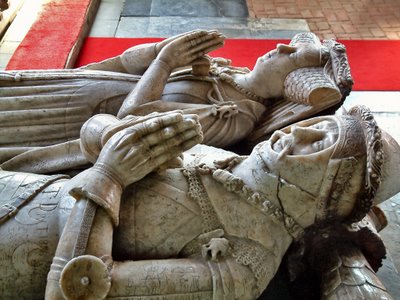Sir Edmund was laid to rest in Ashwellthorpe church, Norfolk, in 1417 after being killed in the siege of Louviers Castle in Normandy on one of Henry V's campaigns. Poor old Sir Edmund's family gave him the most up to date alabaster tomb with an effigy of him in his finest armour, heraldic devices around the base, and a place for his wife alongside him. They must have seen it as a fitting memorial to a man of substance; "a thing of beauty", "a joy forever", as Keats was to later put it.
And it is. The carving is beautifully detailed, recording the costumes of a time long gone. It's a fascinating historical record, and something that helps us to mentally span the ages between now and the early fifteenth century. But then there's the graffiti all over the tomb! Dates from the eighteenth and nineteenth centuries are clearly legible, and multiple large initials and names with serifs look to be of a similar age. On Sir John's breastplate there are a few lines of cursive script, hardly readable now, and on the side of his headgear someone has obviously used a pair of compasses to inscribe a circle enclosing petals! The least sensitive malefactor has hacked initials across the forehead of Lady de Thorp. Who were these people and why did they do it? It can't just have been disgruntled choirboys at a loose end after Sunday service. There is a point of view that says this graffiti is an interesting historical record in itself. It is. However, that shouldn't blind us to the fact that unwanted graffiti is destructive whenever it's perpetrated, and that here it is a sacrilege too.
I was able to take this photograph without the customary tripod because a bright day combined with large windows bathed the tomb in light. Ironically, this drew my attention to the graffiti more than the usual dark church and dimly lit chapel would have done!
photograph & text (c) T. Boughen
